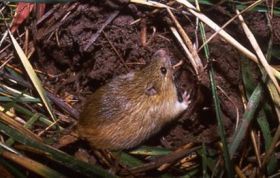The state Department of Game and Fish says recent surveys show the number of New Mexican meadow jumping mice has dropped by at least two-thirds - and possibly as much as 90 percent - throughout the state. Surveys also show the Arizona montane vole is found only in a very small region of Catron County and in east-central Arizona.
"The thing in common between both is the loss of riparian habitat along streams and rivers in the Southwest," said Jim Stuart, a non-game endangered species mammalogist with the Game and Fish Department. "There's a combination of factors. Grazing is often jumped on as a reason, but there have also been climate factors involved like the dewatering of streams and rivers and the lowering of groundwater."

|
| ©AP |
| This undated photo provided by the New Mexico Game and Fish Department shows a New Mexican meadow jumping mouse at a marsh near Espanola, N.M. |
Stuart pointed to the drought that has had New Mexico in its clutches, saying it - along with human management of the landscape - can lead to fragmented or lost habitat and that any species can be affected, not just the meadow jumping mouse and the vole.
The Game and Fish Department is hosting a series of public meetings this week in Raton, Santa Fe, Alamogordo and Silver City to let people know about an effort to develop a recovery plan for the two mammals.
After the meetings, the department will put together a plan and present it to the public for comment and eventually to the state Game Commission for approval. Approval could come next spring, said Leland Pierce, the department's terrestrial species recovery plan coordinator.
Scientists consider the two rodents to be indicator species of the health of New Mexico's riparian areas.
Pierce said riparian areas are important habitat throughout the state.
Of the 867 species of vertebrates known to exist in New Mexico, more than half rely to some extent on aquatic, wetland or riparian habitat for survival, according to the department's Comprehensive Wildlife Conservation Strategy.
The problem is some experts suggest that New Mexico and neighboring Arizona, which also has populations of the New Mexican meadow jumping mouse, have lost an estimated 90 percent of their original riparian ecosystems over the last century.
In New Mexico, Game and Fish scientists did surveys in the 1980s and found the mouse - with its striking yellowish fur and well-developed hind feet - in the Jemez, Sangre de Cristo and Sacramento mountains.
When they followed up with another round of surveys in 2005 and 2006, Stuart said, the habitat at many of the original sites had changed and the mouse was gone.
The mouse and the vole depend on moist meadows along streams and rivers to make their homes, find food and reproduce.
Stuart said the goal of the recovery plan is to protect and improve remaining habitat as well as encourage better streamside management. He said it's possible the plan could call for building artificial wetlands and relocating animals.
The rodents' existing communities are fragmented with many miles in between, making it harder for them to survive, he said.
"Some of them are just hanging on," he said. "These fragmented populations are more vulnerable to being snuffed out the next time a drought comes along."



Reader Comments
to our Newsletter